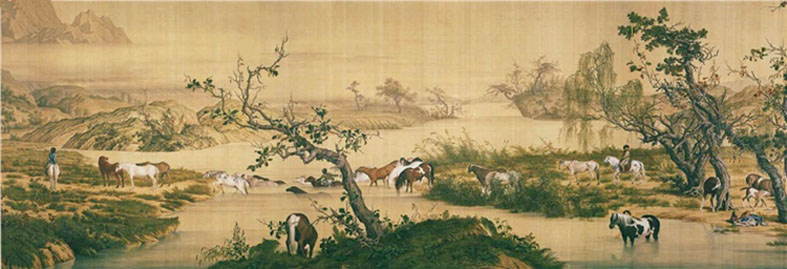Top 10 Chinese paintings (IX): One Hundred Horses

One Hundred Horses
One Hundred Horses is one of the most famous works of Giuseppe Castiglione (1688-1766), called Lang Shining in China. The paper scroll is about one meter tall and eight meters long, and parts of the original scroll are housed at the Metropolitan Museum of Art in New York and the “National Palace Museum” in Taipei.
The Qing Dynasty (1616-1911) marked the peak of Chinese court paintings, and legendary Italian painter Castiglione was an outstanding imperial painter of the era. Influenced by his deft combination of Chinese and Western painting techniques, the Qing court painting formed a unique style. Castiglione was adept at portraits, beasts, birds, flowers and fruits, especially horses, and One Hundred Horses is his masterpiece.
Born in Milan, Castiglione studied painting in Europe when he was young and portrayed icons for churches. In 1715, under the reign of Emperor Kangxi (1662-1722), Castiglione came to China as a Jesuit missionary and joined Ruyi Guan, a royal painting agency, as a court painter in 1723 under the reign of Emperor Yongzheng (1723-1735).
Knowledgeable of architecture, Castiglione assisted in decorating the Old Summer Palace. He applied Western painting techniques on silk paper and integrated Chinese methods to present similarity in forms of appearance on the basis of realistic painting. His introduction of European styles made great contributions to Chinese and Western cultural exchanges.
The long scroll One Hundred Horses depicts a group of horses, with some standing, lying, playing or fighting for food. These horses are scattered throughout the painting and the whole scroll is imbued with a spirit of freedom.
The horses, figures, landscape, grass and trees are drawn delicately and realistically. The accuracy of proportion structure and stereoscopic impression reflected by application of light show Castiglione’s profound expertise in Western painting techniques.
At the same time, drawing the outline and utilizing ink or colors to texturize mountains, stones and tree bark are traditional Chinese painting methods. The greatest impression the scroll leaves is that Castiglione provided a space for imagination. A view of the scroll definitely does not allow the observer to take in everything in a glance but captures people’s limitless imagination.
Castiglione used soft writing brushes but adopted Western painting techniques, such as perspective and light perception to depict flower forms, which reflected Castiglione’s creativity and ability to sketch. He painted meticulously with a great three-dimensional sense. Although it does not use oil paint, the scroll looks as vivid as life, and people cannot help wanting to touch it.
Castiglione introduced almost the majority of European artistic varieties and techniques at that time to China and brought a new vision and aesthetic perception.
